Capacitor Types
From: https://www.electronics-tutorials.ws/capacitor/cap_2.html
Types of Capacitor
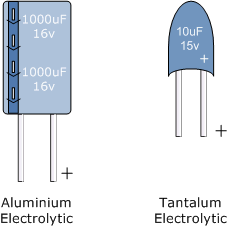
|
Types of Capacitor
There is a large variety of different types of capacitor
available in the market place and each one has its own set
of characteristics and applications
|
The types of capacitor available range from very small delicate trimming
capacitors using in oscillator or radio circuits, up to large power metal-can
type capacitors used in high voltage power correction and smoothing circuits.
The comparisons between the the different types of capacitor is generally made
with regards to the dielectric used between the plates. Like resistors, there
are also variable types of capacitors which allow us to vary their capacitance
value for use in radio or “frequency tuning” type circuits.
Commercial types of capacitors are made from metallic foil interlaced with thin
sheets of either paraffin-impregnated paper or Mylar as the dielectric material.
Some capacitors look like tubes, this is because the metal foil plates are
rolled up into a cylinder to form a small package with the insulating
dielectric material sandwiched in between them.
Small capacitors are often constructed from ceramic materials and then dipped
into an epoxy resin to seal them. Either way, capacitors play an important part
in electronic circuits so here are a few of the more “common” types of capacitor
available.
Dielectric Capacitor
Dielectric Capacitors are usually of the variable type were a continuous
variation of capacitance is required for tuning transmitters, receivers and
transistor radios. Variable dielectric capacitors are multi-plate air-spaced
types that have a set of fixed plates (the stator vanes) and a set of
movable plates (the rotor vanes) which move in between the fixed plates.
The position of the moving plates with respect to the fixed plates
determines the overall capacitance value. The capacitance is generally at
maximum when the two sets of plates are fully meshed together. High voltage
type tuning capacitors have relatively large spacings or air-gaps between
the plates with breakdown voltages reaching many thousands of volts.
Variable Capacitor Symbol
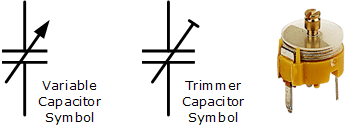 variable capacitor symbol
As well as the continuously variable types of capacitor, preset type
variable capacitors are also available called Trimmers. These are generally
small devices that can be adjusted or “pre-set” to a particular
capacitance value with the aid of a small screwdriver and are available in
very small capacitance’s of 500pF or less and are non-polarized.
variable capacitor symbol
As well as the continuously variable types of capacitor, preset type
variable capacitors are also available called Trimmers. These are generally
small devices that can be adjusted or “pre-set” to a particular
capacitance value with the aid of a small screwdriver and are available in
very small capacitance’s of 500pF or less and are non-polarized.
Film Capacitor Type
Film Capacitors are the most commonly available of all types of capacitor,
consisting of a relatively large family of capacitors with the difference
being in their dielectric properties. These include polyester (Mylar),
polystyrene, polypropylene, polycarbonate, metalised paper, Teflon etc.
Film types of capacitor are available in capacitance ranges from as small as 5pF
to as large as 100uF depending upon the actual type of capacitor and its
voltage rating. Film capacitors also come in an assortment of shapes and
case styles which include:
- Wrap & Fill (Oval & Round) – where the capacitor is wrapped in a
tight plastic tape and have the ends filled with epoxy to seal them.
- Epoxy Case (Rectangular & Round) – where the capacitor is encased in
a moulded plastic shell which is then filled with epoxy.
- Metal Hermetically Sealed (Rectangular & Round) – where the
capacitor is encased in a metal tube or can and again sealed with epoxy.
with all the above case styles available in both Axial and Radial Leads.
Film Capacitors which use polystyrene, polycarbonate or Teflon as their
dielectrics are sometimes called “Plastic capacitors”. The construction
of plastic film capacitors is similar to that for paper film capacitors but
use a plastic film instead of paper.
The main advantage of plastic film types of capacitor compared to
impregnated-paper types is that they operate well under conditions of high
temperature, have smaller tolerances, a very long service life and high
reliability. Examples of film capacitors are the rectangular metalised film
and cylindrical film & foil types as shown below.
Radial Lead Type
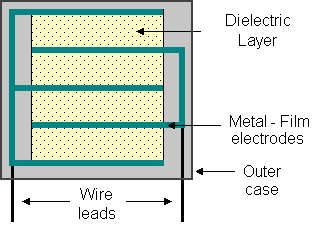 radial lead capacitor
radial lead capacitor
Axial Lead Type
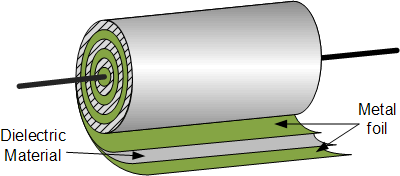 metalised foil capacitor
The film and foil types of capacitor are made from long thin strips of thin
metal foil with the dielectric material sandwiched together which are wound
into a tight roll and then sealed in paper or metal tubes.
film capacitor type
metalised foil capacitor
The film and foil types of capacitor are made from long thin strips of thin
metal foil with the dielectric material sandwiched together which are wound
into a tight roll and then sealed in paper or metal tubes.
film capacitor type
|
|
|
These film types require a much thicker dielectric film to reduce the risk
of tears or punctures in the film, and is therefore more suited to lower
capacitance values and larger case sizes.
| 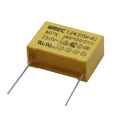
|
Metalised foil capacitors have the conductive film metalised sprayed
directly onto each side of the dielectric which gives the capacitor self
-healing properties and can therefore use much thinner dielectric films.
This allows for higher capacitance values and smaller case sizes for a given
capacitance. Film and foil capacitors are generally used for higher power
and more precise applications.
Ceramic Types of Capacitor
Ceramic Capacitors or Disc Capacitors as they are generally called, are made
by coating two sides of a small porcelain or ceramic disc with silver and
are then stacked together to make a capacitor. For very low capacitance
values a single ceramic disc of about 3-6mm is used. Ceramic capacitors have
a high dielectric constant (High-K) and are available so that relatively
high capacitance’s can be obtained in a small physical size.
ceramic construction
|
|
|
They exhibit large non-linear changes in capacitance against temperature and
as a result are used as de-coupling or by-pass capacitors as they are also
non-polarized devices. Ceramic capacitors have values ranging from a few
picofarads to one or two microfarads, ( μF ) but their voltage ratings are
generally quite low.
Ceramic types of capacitors generally have a 3-digit code printed onto their
body to identify their capacitance value in pico-farads.
|
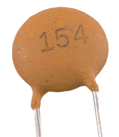
|
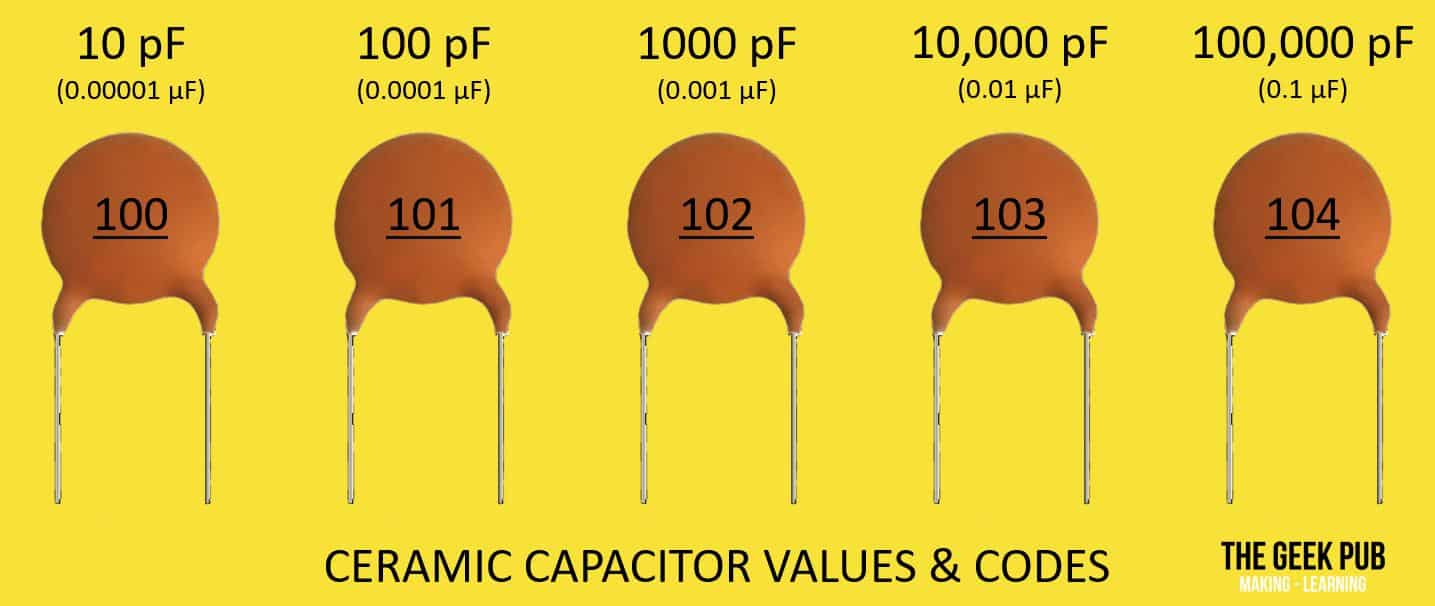 Let’s break that 3 digit code!
The first two digits are the capacitance value in pF and the third digit is
simply a multiplier. This is where you need a good memory, or the calculator!
The multiplier is always a number between zero and six. If you find a larger
number than six, it is not using the standard numbering scheme, or it may not
even be a capacitor.
Ceramic Capacitor Multipliers
Here’s a simple table of the multipliers you can use to do this calculation in
your head:
Let’s break that 3 digit code!
The first two digits are the capacitance value in pF and the third digit is
simply a multiplier. This is where you need a good memory, or the calculator!
The multiplier is always a number between zero and six. If you find a larger
number than six, it is not using the standard numbering scheme, or it may not
even be a capacitor.
Ceramic Capacitor Multipliers
Here’s a simple table of the multipliers you can use to do this calculation in
your head:
- multiply by 1
- multiply by 10
- multiply by 100
- multiply by 1000
- multiply by 10,000
- multiply by 100,000
- multiply by 1,000,000
Generally the first two digits indicate the capacitors value and the third digit
indicates the number of zero’s to be added. For example, a ceramic disc
capacitor with the markings 103 would indicate 10 and 3 zero’s in pico-farads
which is equivalent to 10,000 pF or 10nF.
Likewise, the digits 104 would indicate 10 and 4 zero’s in pico-farads
which is equivalent to 100,000 pF or 100nF and so on. So on the image of the
ceramic capacitor above the numbers 154 indicate 15 and 4 zero’s in pico
-farads which is equivalent to 150,000 pF or 150nF or 0.15μF. Letter codes
are sometimes used to indicate their tolerance value such as: J = 5%, K =
10% or M = 20% etc.
Electrolytic Types of Capacitor
Electrolytic Capacitors are generally used when very large capacitance
values are required. Here instead of using a very thin metallic film layer
for one of the electrodes, a semi-liquid electrolyte solution in the form of
a jelly or paste is used which serves as the second electrode (usually the
cathode).
The dielectric is a very thin layer of oxide which is grown electro
-chemically in production with the thickness of the film being less than ten
microns. This insulating layer is so thin that it is possible to make
capacitors with a large value of capacitance for a small physical size as
the distance between the plates, d is very small.
electrolytic
|
|
|
The majority of electrolytic types of capacitors are Polarised, that is the
DC voltage applied to the capacitor terminals must be of the correct
polarity, i.e. positive to the positive terminal and negative to the
negative terminal as an incorrect polarisation will break down the
insulating oxide layer and permanent damage may result.
|
| 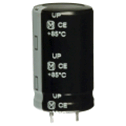
Electrolytic Capacitor
|
All polarised electrolytic capacitors have their polarity clearly marked
with a negative sign to indicate the negative terminal and this polarity
must be followed.
Electrolytic Capacitors are generally used in DC power supply circuits due
to their large capacitance’s and small size to help reduce the ripple
voltage or for coupling and decoupling applications. One main disadvantage
of electrolytic capacitors is their relatively low voltage rating and due to
the polarisation of electrolytic capacitors, it follows then that they must
not be used on AC supplies. Electrolytic’s generally come in two basic
forms; Aluminium Electrolytic Capacitors and Tantalum Electrolytic
Capacitors.
Electrolytic Capacitor
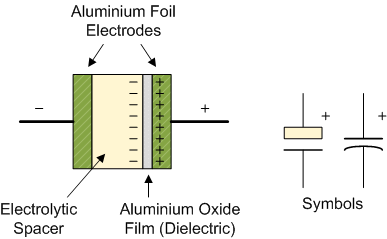 aluminium electrolytic construction
aluminium electrolytic construction
1. Aluminium Electrolytic Types of Capacitor
There are basically two types of Aluminium Electrolytic Capacitor, the plain
foil type and the etched foil type. The thickness of the aluminium oxide
film and high breakdown voltage give these capacitors very high capacitance
values for their size.
The foil plates of the capacitor are anodized with a DC current. This
anodizing process sets up the polarity of the plate material and determines
which side of the plate is positive and which side is negative.
The etched foil type differs from the plain foil type in that the aluminium
oxide on the anode and cathode foils has been chemically etched to increase
its surface area and permittivity. This gives a smaller sized capacitor
than
a plain foil type of equivalent value but has the disadvantage of not being
able to withstand high DC currents compared to the plain type. Also their
tolerance range is quite large at up to 20%. Typical values of capacitance
for an aluminium electrolytic capacitor range from 1uF up to 47,000uF.
Etched foil electrolytic’s are best used in coupling, DC blocking and by
-pass circuits while plain foil types are better suited as smoothing
capacitors in power supplies. But aluminium electrolytic’s are “polarised”
devices so reversing the applied voltage on the leads will cause the insulating
layer within the capacitor to become destroyed along with the capacitor.
However, the electrolyte used within the capacitor helps heal a damaged plate
if the damage is small.
Since the electrolyte has the properties to self-heal a damaged plate, it also
has the ability to re-anodize the foil plate. As the anodizing process can be
reversed, the electrolyte has the ability to remove the oxide coating from the
foil as would happen if the capacitor was connected with a reverse polarity.
Since the electrolyte has the ability to conduct electricity, if the aluminium
oxide layer was removed or destroyed, the capacitor would allow current to pass
from one plate to the other destroying the capacitor, “so be aware”.
2. Tantalum Electrolytic Types of Capacitor
Tantalum Electrolytic Capacitors and Tantalum Beads, are available in both
wet (foil) and dry (solid) electrolytic types with the dry or solid tantalum
being the most common. Solid tantalum capacitors use manganese dioxide as
their second terminal and are physically smaller than the equivalent
aluminium capacitors.
The dielectric properties of tantalum oxide is also much better than those
of aluminium oxide giving a lower leakage currents and better capacitance
stability which makes them suitable for use in blocking, by-passing,
decoupling, filtering and timing applications.
Also, Tantalum Capacitors although polarised, can tolerate being connected
to a reverse voltage much more easily than the aluminium types but are rated
at much lower working voltages. Solid tantalum capacitors are usually used
in circuits where the AC voltage is small compared to the DC voltage.
However, some tantalum capacitor types contain two capacitors in-one,
connected negative-to-negative to form a “non-polarised” capacitor for
use in low voltage AC circuits as a non-polarised device. Generally, the
positive lead is identified on the capacitor body by a polarity mark, with
the body of a tantalum bead capacitor being an oval geometrical shape.
Typical values of capacitance range from 47nF to 470uF.
Aluminium & Tantalum Electrolytic Capacitor
| 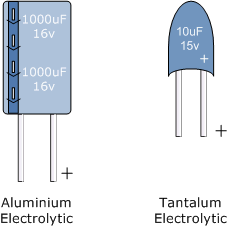 Electrolytic’s are widely used capacitors due to their low cost and small
size but there are three easy ways to destroy an electrolytic capacitor:
Electrolytic’s are widely used capacitors due to their low cost and small
size but there are three easy ways to destroy an electrolytic capacitor:
- Over-voltage – excessive voltage will cause current to leak through
the dielectric resulting in a short circuit condition.
- Reversed Polarity – reverse voltage will cause self-destruction of
the oxide layer and failure.
- Over Temperature – excessive heat dries out the electrolytic and
shortens the life of an electrolytic capacitor.
In the next tutorial about Capacitors, we will look at some of the main
characteristics to show that there is more to the Capacitor than just
voltage and capacitance.
previousPrevious
Introduction to Capacitors
Next
Capacitor Characteristics
next
|


 variable capacitor symbol
As well as the continuously variable types of capacitor, preset type
variable capacitors are also available called Trimmers. These are generally
small devices that can be adjusted or “pre-set” to a particular
capacitance value with the aid of a small screwdriver and are available in
very small capacitance’s of 500pF or less and are non-polarized.
variable capacitor symbol
As well as the continuously variable types of capacitor, preset type
variable capacitors are also available called Trimmers. These are generally
small devices that can be adjusted or “pre-set” to a particular
capacitance value with the aid of a small screwdriver and are available in
very small capacitance’s of 500pF or less and are non-polarized.
 radial lead capacitor
radial lead capacitor
 metalised foil capacitor
The film and foil types of capacitor are made from long thin strips of thin
metal foil with the dielectric material sandwiched together which are wound
into a tight roll and then sealed in paper or metal tubes.
film capacitor type
metalised foil capacitor
The film and foil types of capacitor are made from long thin strips of thin
metal foil with the dielectric material sandwiched together which are wound
into a tight roll and then sealed in paper or metal tubes.
film capacitor type


 Let’s break that 3 digit code!
The first two digits are the capacitance value in pF and the third digit is
simply a multiplier. This is where you need a good memory, or the calculator!
The multiplier is always a number between zero and six. If you find a larger
number than six, it is not using the standard numbering scheme, or it may not
even be a capacitor.
Ceramic Capacitor Multipliers
Here’s a simple table of the multipliers you can use to do this calculation in
your head:
Let’s break that 3 digit code!
The first two digits are the capacitance value in pF and the third digit is
simply a multiplier. This is where you need a good memory, or the calculator!
The multiplier is always a number between zero and six. If you find a larger
number than six, it is not using the standard numbering scheme, or it may not
even be a capacitor.
Ceramic Capacitor Multipliers
Here’s a simple table of the multipliers you can use to do this calculation in
your head:

 aluminium electrolytic construction
aluminium electrolytic construction
 Electrolytic’s are widely used capacitors due to their low cost and small
size but there are three easy ways to destroy an electrolytic capacitor:
Electrolytic’s are widely used capacitors due to their low cost and small
size but there are three easy ways to destroy an electrolytic capacitor: